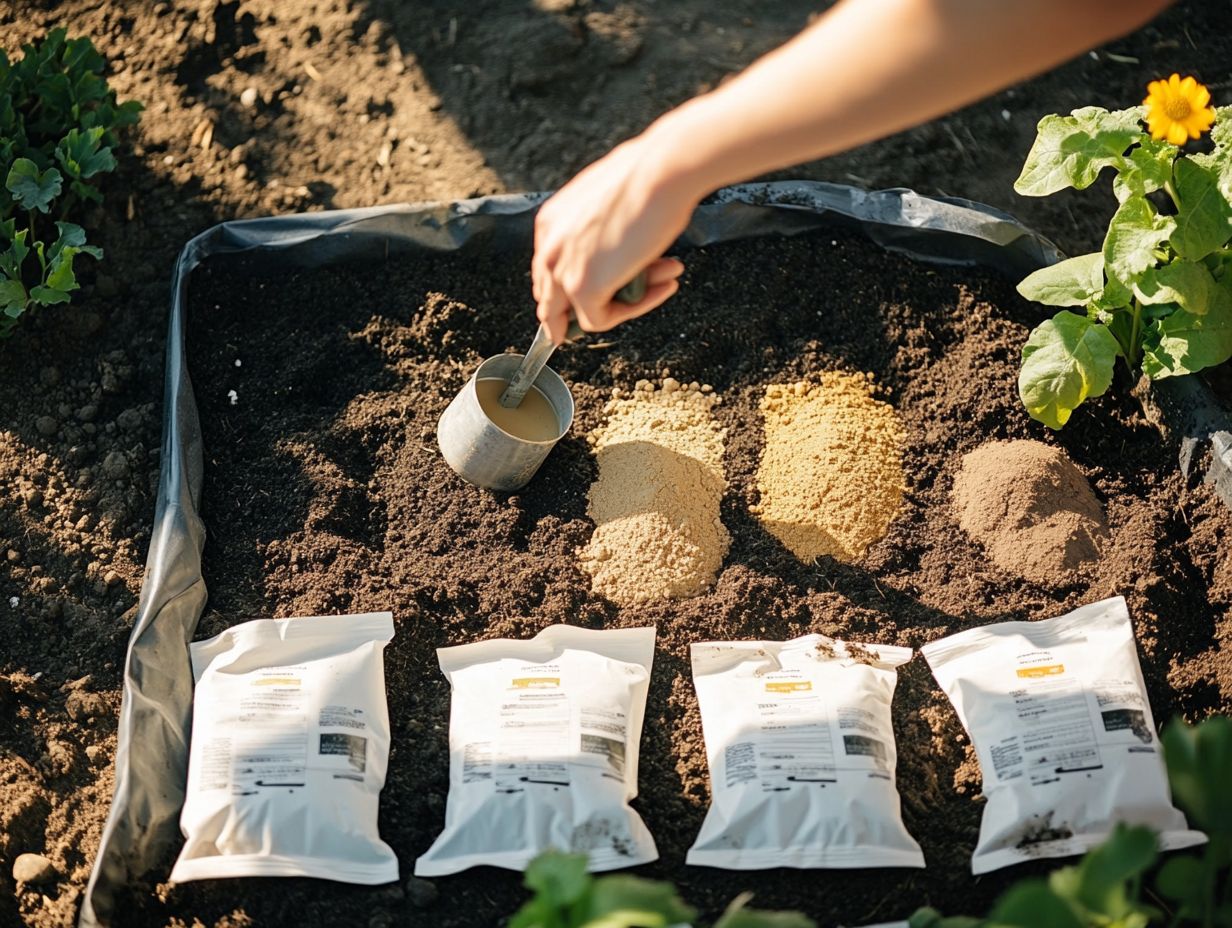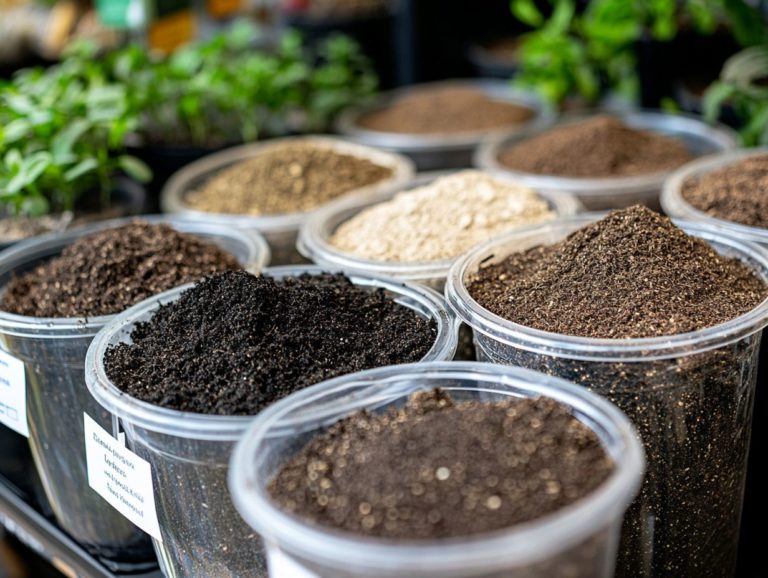What You Need to Know About Fertilizer Ratios
Understanding fertilizer ratios is essential for anyone who aims to cultivate vibrant, healthy plants. These ratios, typically shown as a series of numbers, reflect the balance of critical nutrients such as nitrogen, phosphorus, and potassium each playing a vital role in plant growth.
An imbalanced ratio can compromise your plants’ health, underscoring the importance of selecting the right formulation tailored to your specific botanical needs.
This article delves into the significance of these ratios, examines various types of fertilizers, and offers guidance on how to apply the ideal mix to achieve optimal results.
Contents
- Key Takeaways:
- Understanding Fertilizer Ratios
- The Importance of Balanced Fertilizer Ratios
- Types of Fertilizer Ratios
- Choosing the Right Fertilizer Ratio
- Applying Fertilizer with the Correct Ratio
- Adjusting Fertilizer Ratios for Different Plants
- Frequently Asked Questions
- What is a fertilizer ratio and why is it important?
- How do I read a fertilizer ratio?
- What is the ideal fertilizer ratio for my plants?
- Can I mix different fertilizers to create a custom ratio?
- How often should I apply fertilizer with a specific ratio?
- Are there any dangers of using the wrong fertilizer ratio?
Key Takeaways:

- Understanding fertilizer ratios is crucial for maintaining healthy plants.
- Imbalanced ratios can have negative effects on plants, so it’s important to choose a balanced fertilizer ratio.
- Consider the specific needs of your plants and the ratio of nitrogen, phosphorus, and potassium when choosing the right fertilizer for optimal growth.
Understanding Fertilizer Ratios
Grasping fertilizer ratios is essential for anyone engaged in gardening or lawn care. These ratios dictate the nutrient content vital for fostering healthy growth and achieving optimal soil fertility.
A precise balance of nitrogen, phosphorus, and potassium (the ratio of nitrogen, phosphorus, and potassium) is key. This balance ensures that plants receive the large and small nutrients necessary at various growth stages.
This balance influences everything from root system development to resilience against diseases.
Understanding how to test soil pH helps you choose between organic options like composted manure and synthetic fertilizers that offer rapid nutrient release.
What do the Numbers Mean?
The numbers on fertilizer packages represent the N-P-K ratio, indicating the relative amounts of nitrogen, phosphorus, and potassium essential nutrients for thriving plant growth.
Each of these nutrients plays a vital role in different aspects of plant development. Nitrogen is crucial for promoting leafy growth, enhancing chlorophyll production, and ensuring the health of your foliage, especially for leafy vegetables.
On the other hand, phosphorus supports robust root development and is integral to the formation of flowers and fruits, making it particularly important during blooming periods.
Potassium, meanwhile, bolsters overall plant health by improving disease resistance and promoting moisture retention.
By understanding the N-P-K ratio on fertilizer packages, you can select the perfect blend tailored to your plants’ specific needs, whether you’re nurturing seedlings in the spring or preparing them to withstand the challenges of summer heat.
The Importance of Balanced Fertilizer Ratios
Balanced fertilizer ratios play a crucial role in maintaining your plants’ health. They ensure optimal nutrient uptake throughout their various growth stages.
By achieving the right balance, you significantly reduce the risk of nutrient deficiencies that can hinder healthy growth.
An imbalanced ratio makes it hard for plants to absorb nutrients. This leads to poor root development and weakened disease resistance, ultimately impacting both yield and quality.
Effects of Imbalanced Ratios on Plants
Imbalanced fertilizer ratios can create nutrient gaps that harm your plants. This can negatively impact plant health, root growth, and disease resistance, potentially inflicting long-term harm to your garden or lawn.
For example, when your soil lacks sufficient nitrogen, you might notice your plants exhibiting stunted growth, yellowing leaves, and poor flowering.
A deficiency in phosphorus can result in dark green or purplish foliage, coupled with a reduced root system, while potassium shortages often present as scorched leaf tips and weak stems.
To address these imbalances, conducting a soil test is essential. This will provide you with a clear picture of nutrient levels and guide you in making the necessary amendments.
Interestingly, many home gardeners encounter these issues without understanding the root causes. However, with careful analysis and adjustments, you can effectively revive your green spaces and cultivate a flourishing garden.
With the right balance, you can watch your garden flourish and thrive!
Types of Fertilizer Ratios

You ll encounter a range of fertilizer ratios, with the N-P-K ratios standing out prominently. These ratios, found in both organic and synthetic fertilizers, are designed to meet the diverse needs of your garden and the specific requirements of various plant types.
Nitrogen-Phosphorus-Potassium (N-P-K)
The N-P-K ratio is vital for understanding fertilizer grades. It details the percentages of nitrogen, phosphorus, and potassium within the product.
This trio of nutrients plays unique yet interrelated roles in fostering plant health and development.
Nitrogen encourages lush leaf growth, aids in chlorophyll production, and enhances photosynthesis.
Phosphorus is crucial for robust root development and flower production. It ensures that plants lay a solid foundation while gearing up for stunning blooms.
Potassium contributes significantly to overall plant vitality. It assists with water regulation and bolsters disease resistance.
When selecting fertilizers, consider the specific requirements of your plants. Use the N-P-K ratio to customize the nutrient composition for optimal growth results.
Other Essential Nutrients
Alongside the primary N-P-K nutrients, several important nutrients like calcium, magnesium, and sulfur are essential for optimal plant health.
These nutrients play crucial roles in various physiological processes, enhancing plants’ ability to absorb water and nutrients. They promote vigorous growth and abundant flowering.
For instance, calcium, often sourced from lime or gypsum, strengthens cell walls and supports root development, helping your plants fend off diseases.
Magnesium, found in Epsom salts, is vital for chlorophyll production, boosting photosynthesis and overall plant vitality.
Sulfur, typically available in compost and certain fertilizers, is key for protein synthesis and enzyme function.
To effectively integrate these nutrients into your gardening practices, apply soil amendments like dolomitic lime to balance pH while supplying essential minerals. This ensures a well-rounded nutrient profile, paving the way for thriving plants.
Choosing the Right Fertilizer Ratio
Selecting the optimal fertilizer ratio is key to unlocking your gardening success! It’s not just about the N-P-K needs of your plants; you must also consider soil pH and regular soil testing to confirm that your nutrients are on point.
Your careful attention to these details will pave the way for a thriving garden.
Factors to Consider
When selecting fertilizers, consider several crucial factors: soil pH, plant type, and the specific growth stages of your plants.
Understanding how different plants respond to various nutrient levels is essential. Some species thrive in nutrient-rich environments, while others prefer less fertile conditions.
Seasonal changes significantly impact fertilizer requirements. For example, in spring, providing a nitrogen boost spurs lush growth, whereas in fall, potassium is vital for strengthening roots before winter.
Timing is crucial. Applying fertilizers too early or too late can impede absorption and diminish their benefits. How you apply fertilizers also matters whether through broadcasting, foliar feeding, or soil incorporation greatly influences the effectiveness of nutrient delivery, supporting the health and vitality of your plants.
Applying Fertilizer with the Correct Ratio

Applying fertilizer in the right ratio is crucial for maximizing nutrient absorption and fostering robust plant growth, whether you choose granular or soluble fertilizers.
By ensuring the correct application, you set the stage for thriving greenery and flourishing blooms.
Start implementing these tips today and watch your garden thrive!
Methods and Techniques
Explore various methods and techniques for applying fertilizers. Options include compost tea and a variety of gardening tools to ensure even distribution and effective nutrient delivery.
These techniques fit various gardening styles and meet your plants’ specific needs, elevating your gardening experience. For instance, broadcasting granular fertilizers is straightforward and works well for larger areas. In contrast, drip irrigation systems offer targeted nutrient applications for delicate plants, helping to reduce waste.
Foliar feeding provides quick nutrient boosts but requires careful timing and good weather to be effective. By adapting these methods to various soil types and plant preferences, you maximize growth potential and support sustainable gardening practices.
Understanding the advantages and limitations of each approach enables you to make informed decisions that lead to thriving plants and a productive garden.
Adjusting Fertilizer Ratios for Different Plants
Adjusting fertilizer ratios for different plants is essential to meet their specific nutritional needs, or the nutrients plants need to grow well. Tailoring these ratios can supercharge your plants’ root systems and ensure optimal nutrient uptake, both vital for healthy growth especially in vegetable crops.
Specific Needs of Different Plants
Different plants have unique nutrient needs, requiring tailored nutrient ratios to optimize their growth and development in your vegetable garden. Understanding these requirements is crucial for anyone aiming to cultivate a flourishing garden.
Take leafy greens like spinach and kale; they thrive on elevated nitrogen levels that promote lush foliage. Root vegetables, such as carrots and beets, flourish with a balanced nutrient ratio that includes phosphorus to support robust root development. Tomato plants crave a nutrient mix rich in potassium to enhance fruiting.
By grasping the specific demands of each plant family, you can implement effective strategies like soil testing and utilizing organic fertilizers to achieve the right nutrient balance. This knowledge leads to healthier yields and bountiful harvests, making your gardening efforts truly rewarding.
Frequently Asked Questions
Got questions about fertilizer? Here are some common ones answered!
What is a fertilizer ratio and why is it important?

A fertilizer ratio refers to the percentage of nitrogen, phosphorus, and potassium (NPK) contained in a specific fertilizer. These three nutrients are essential for plant growth, and each serves a different purpose in plant development.
How do I read a fertilizer ratio?
A fertilizer ratio is typically displayed as three numbers, such as 10-10-10. The first number represents the percentage of nitrogen, the second number represents phosphorus, and the third number represents potassium.
What is the ideal fertilizer ratio for my plants?
The ideal fertilizer ratio depends on the type of plants you are growing and their specific nutrient needs. For example, leafy greens and grasses typically require a higher nitrogen ratio, while flowering plants and fruits may benefit from a higher phosphorus ratio.
Can I mix different fertilizers to create a custom ratio?
Yes, you can mix different fertilizers to create a custom ratio that meets your plants’ specific needs. However, be cautious and always follow the recommended application rates to avoid over-fertilizing your plants.
How often should I apply fertilizer with a specific ratio?
The frequency of fertilizer application depends on your plants’ specific needs and the type of fertilizer you are using. Some fertilizers may need to be applied more frequently, so be sure to follow the manufacturer’s recommendations for best results.
Are there any dangers of using the wrong fertilizer ratio?
Using the wrong fertilizer ratio can harm your plants or cause nutrient imbalances in the soil. This can lead to stunted growth, discoloration, or even death of your plants. It’s important to do your research and choose the right fertilizer ratio for your specific plants.






